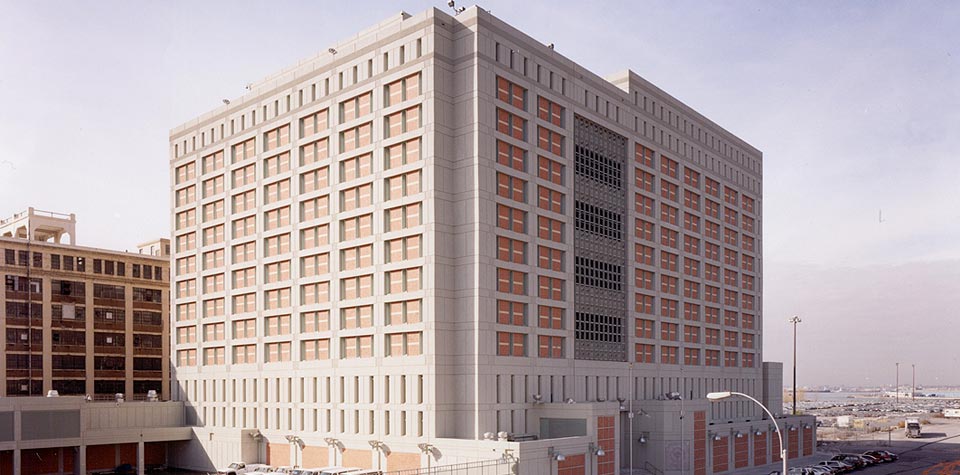At a New York City federal prison that’s recorded relatively few confirmed cases of COVID-19, medical requests made by incarcerated people during the pandemic topped the usual number by hundreds. Many went unaddressed for weeks, according to a federal watchdog report published on November 10. The failure to respond to the medical needs of people who are incarcerated appears to be borne of the facility’s dire medical staffing shortage.
According to the US Department of Justice’s Office of the Inspector General report, requests for medical attention by prisoners at the Bureau of Prison’s (BOP) Metropolitan Detention Center in Brooklyn (MDC-Brooklyn) have surged during the COVID-19 crisis relative to pre-pandemic numbers. A total of 2,160 requests were filed between March 2 and September 23 of this year, compared to 1,649 during that same period last year.
BOP did not respond to Filter‘s request for comment.
Many of the requests describe fears of exposure to COVID-19. “Please allow someone to see me immediately, I am high risk for the Corona Virus. Not saying I have it, but would love immediate care if I do end positive,” wrote one prisoner in a redacted March 29 request made publicly available by the The Intercept. Two days earlier, another wrote that “i had a cold a few weeks ago i was never seen but now i have this cough like i am choking on spit and my chest and heart hurts when i am breathing.”
The modest number of confirmed COVID-19 cases among those incarcerated at MDC-Brooklyn—16, as of November 10—is almost certainly an undercount. The facility had a limited supply of testing equipment, but less than half of the kits it did have between March and May were actually used. MDC-Brooklyn Health Services staff simply assumed some prisoners were positive, reserving testing “generally” for “only symptomatic inmates housed in units without a confirmed case.”
The Health Services team wasn’t prepared to meet their incarcerated population’s needs. “Patients may repeatedly submit sick call requests with COVID-19 concerns, but the facility lacks the clinical response to find and care for those individuals,” wrote former NYC Correctional Health Services medical director Dr. Homer Venters in a report on MDC-Brooklyn for a lawsuit filed by incarcerated plaintiffs in April.
From the early days of the pandemic through September, the facility had a single doctor on staff (compared to MDC-Brooklyn’s usual three, pre-COVID-19) while only half of Mid-Level Providers were available (three out of six). Two new temporary medical workers joined the MDC-Brooklyn team in April, bringing the total number of employees up to 22. The authorized count is 30.
MDC-Brooklyn staff knew the shortage was a problem. A majority of the facility’s respondents to the OIG survey (71 percent) identified “Additional staff to cover posts” as an immediate need, compared to 39 percent of BOP-wide respondents.
“The shortage of medical staff at MDC Brooklyn was among the biggest challenges in appropriately screening inmates and staff members for COVID‑19 symptoms,” states the OIG report. “This shortage continued through September 2020 and resulted in MDC Brooklyn struggling to meet the medical needs of non–COVID‑19 inmates.”
As a result, hundreds of medical requests have gone unaddressed for months at a time. One hundred twenty-five requests submitted in March, approaching the height of the outbreak, remained unaddressed by May 1. Even after the pandemic’s epicenter moved out of New York City, the high number of requests continued—many with the same attending delays. Of an unspecified number of requests made in early July, 160 had not been scheduled or seen by September 23.
For those requests that were lucky enough to receive responses, Venters stated in his report, the subsequent action was insufficient. “After multiple requests, the only response was for a health staffer to come to their cell and take their temperature,” Venters wrote, a practice he cites as a “serious deviation from accepted standards.” He found that “no thorough symptoms were elicited and no other physical examinations were conducted.”
The full picture of the quality of Health Services’ responses has been obstructed by staff. According to Venters, employees were destroying the paper request slips during the early days of the city’s outbreak, up until a court intervened. “This represents a gross deviation from basic health care standards because the sick-call requests form part of the patient’s medical record,” he wrote. “[It] renders impossible any evaluation of whether the assessment and care provided was appropriate to the patient’s original concerns.”
In a letter (attached to the report) responding to the OIG findings, BOP claimed that medical providers “triaged paper and electronic requests daily and attended to cases as clinically indicated per triage guidelines.” Staff responses and adherence to guidelines were not evaluated by OIG, though the investigators were told by interviewees that the shortage caused “negative outcomes, including increased workload, challenges in responding to sick call requests, and mandatory overtime.”
The BOP and Health Services team also attributed the long wait times to the use of paper, rather than digital, request forms, and to the requirement that providers see patients within the housing units.
Photograph of MDC-Brooklyn via Bureau of Prisons/Public Domain





Show Comments